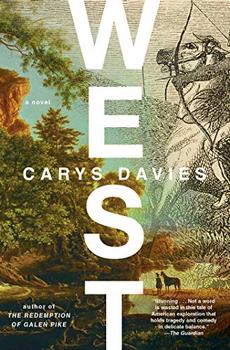Summary | Excerpt | Reading Guide | Reviews | Beyond the Book | Read-Alikes | Genres & Themes | Author Bio

This article relates to West
 Carys Davies' novella West, is set a decade after the famous Lewis and Clark Expedition. Protagonist John Cyrus Bellman's obsession with journeying into the West echoes the ambitions and objectives of the famous adventurers Meriwether Lewis and William Clark who desired to explore the unknown American frontier and detail what they found there.
Carys Davies' novella West, is set a decade after the famous Lewis and Clark Expedition. Protagonist John Cyrus Bellman's obsession with journeying into the West echoes the ambitions and objectives of the famous adventurers Meriwether Lewis and William Clark who desired to explore the unknown American frontier and detail what they found there.
The Lewis and Clark Expedition took place over two years from 1804 to 1806, and it was the first European expedition to cross the continental divide and travel through the western portion of the United States to reach the Pacific Northwest. The journey began in St. Louis, Missouri in May 1804, and continued through what today are known as Kansas City, Missouri and Omaha, Nebraska.

President Thomas Jefferson commissioned a special unit within the army, called The Corps of Discovery, which supported the expedition. Launched shortly after the Louisiana Purchase in 1803, the express goal of the undertaking was to map the newly acquired territory and navigate a route across the western half of the continent, and, equally important, to establish an American presence in this unclaimed land before Britain and other European powers did so. The Corps was made up of some 50 volunteers and enlisted men and faced unimaginable obstacles during their travels. Aside from the difficult terrain to navigate, they experienced extreme weather conditions of all kinds, which left many men ill and injured and in a near constant state of fatigue and hunger. Nevertheless, along the way, the group made many scientific discoveries, including over 200 new animal and plant species.
The expedition also established relations with over 70 Native American tribes who were of immense help to the explorers as they gave them food during the extreme winters and guided them through these new lands. The Shoshone woman, Sacagawea, brought along her infant son, and was an invaluable ally. There were also a few scuffles and cultural misunderstandings with the Native Americans that led to heated confrontations. However, for the most part it seems there wasn't much outright violence between the Corps and any tribes, and negotiations were settled by peaceful trade.
In November 1805, the expedition finally set foot on the Pacific coast. The arrival was not a particularly joyous occasion as the group arrived during a severe winter and they were short on food and supplies. By moving camp to the south side of the Columbia River, they managed to survive the harsh winter, which lasted until the following March, before they finally began their journey home on March 23, 1806. During the journey back, the Corps decided to temporarily split into two teams to explore different areas of the land. They were reunited a month later in Yellowstone, where a bizarre accident ended with Lewis being shot in the thigh as he was mistaken for an elk by one of Clark's hunters. The expedition arrived back in St. Louis on September 23, 1806.
Editor's Note: The National Archives has many incredible written records of the expedition, which are worth exploring. Historian Ken Burns produced a documentary about the expedition and clips can be found on PBS.
Picture of map by Victor van Werkhooven
Filed under People, Eras & Events
![]() This "beyond the book article" relates to West. It originally ran in May 2018 and has been updated for the
April 2019 paperback edition.
Go to magazine.
This "beyond the book article" relates to West. It originally ran in May 2018 and has been updated for the
April 2019 paperback edition.
Go to magazine.
Your guide toexceptional books
BookBrowse seeks out and recommends the best in contemporary fiction and nonfiction—books that not only engage and entertain but also deepen our understanding of ourselves and the world around us.